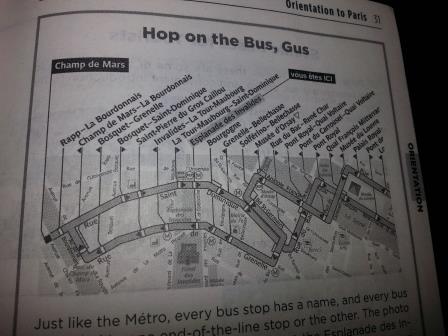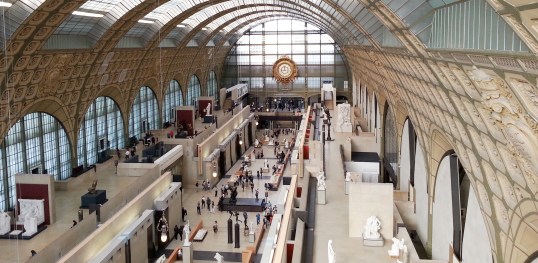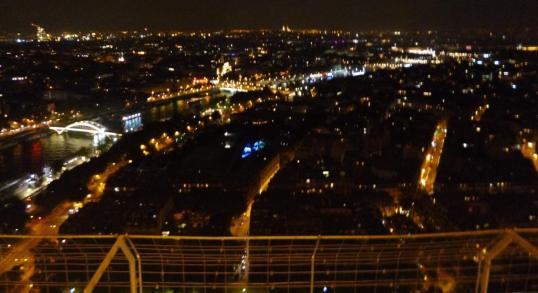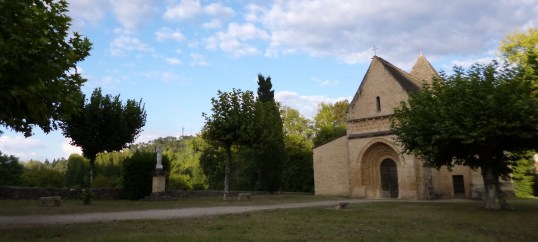My favorite pied a terre in Paris is the Jardin D’Eiffel, just off the market street Rue Cler (see above) by one block. 15 years ago when I first stayed the decor was dominated by giant yellow Monet-esque flowers on Royal blue on drapes, pictures, and murals throughout (see below) , and the clientele favored busloads of Canadian and German students and tourists on a budget.
The old Jardin has undergone a 21st century revamp, and is now robed mostly in subtle shades of gray with some paisley drapes to brighten the feel (see above). The elevator, however, is no larger; it can accommodate two people and two suitcases on if you are on friendly terms, or you can stash the suitcases in the elevator, push the button,and race the elevator up the stairs. DB and I are sharing a room facing the street – not the best, as the next door neighbor is the police station and we expect to hear sirens all night. From the back rooms, if you lean out the window, you can glimpse the Eiffel Tower.
We arrived after an efficient breakfast at La Vielle Auberge, a lightning transit to the train station in Souillac, a bit of a hassle with ticket’s but we eventually got on the train and enjoyed four hours of French scenery, shading from Romanesque yellow sandstone with steep-pitched roofs and bell-towers in the Dordogne to white stucco with mansard roofs and steeples in the Touraine. Gare Austerlitz is large and bustling but well-signed, our Algerian taxi driver was friendly and expansive about what we should be sure to see in Paris, and the staff at the Jardin welcomed us like old friends.
We took the Metro to the Place de ‘l’Opera and picked up our museum passes for two days of urgent museum – going. This may be our last joint adventure for awhile, as we each have different plans for our stay in Paris. WB missed the Louvre on her previous visit and expects to spend two days there, but wants also to fit in the renovated Musee d’Orsay, the Rodin, the Pere LaChaise cemetery, and perhaps a tour of the opera. DM has a friend dating back to a working stint in London who came to meet her and is staying at the Jardin, and also has a cousin who wants to return the hospitality DM showed him in the states, so after tonight’s dinner she will not share evenings until Sunday. Dianne has not been in Paris in decades and has murky memories, so she may take the #69 bus tour around the city per Rick Steves’ recommendation and then follow her interests. 
I have in mind the renovated d’Orsay tomorrow together with l’Orangerie which houses Monet’s water lilies, then there is another exhibit at the Grand Palais I want to find out about, and I need to visit Notre Dame and the Holocaust victims memorial and of course Berthillon’s ice cream and the Art Deco atrium of La Samaritaine, and Le Pere LaChaise cemetery with WB on Sunday. Our walking tour will have been good prep for pounding all this Gothic pavement. Right now we are getting cleaned up in preparation for a celebration meal at l’Affriole, which it appears has developed enough of a reputation that Michele (who is French with family and friends in Lyon) had heard of it.
I am trembling at the potential cost. But we have economized greatly up until now, having scrounged for lunches at the hotel breakfast buffets and having dinner and breakfasts prepaid during our hiking tour.
 We decided to walk back from L’Opera (which was undergoing a revamp of its own behind a Rene Magritte-inspired façade) and stopped at a street-side cafe on Rue Tour Maubourg for wine, tea, and people -watching. We saw Cinderella’s glass coach go by, pulled by a rather ordinary brown horse and with two dotty English tourists inside. Such is life in a tourist city.
We decided to walk back from L’Opera (which was undergoing a revamp of its own behind a Rene Magritte-inspired façade) and stopped at a street-side cafe on Rue Tour Maubourg for wine, tea, and people -watching. We saw Cinderella’s glass coach go by, pulled by a rather ordinary brown horse and with two dotty English tourists inside. Such is life in a tourist city.
Unfortunately l’Affriole did not live up to my memory. New management has revamped the decor here also, opening up the front of the place for sidewalk seating, which leaves one exposed to the curious glances of passers-by and other hazards. In our case, a large dog decided to deposit an equally large souvenir on the sidewalk just by our table, and the dog’s owner loftily prepared to ignore the awkward incident until the restaurateur bounded out and demand she clean up after her pet. She argued, gave in, and “cleaned up” by kicking the mess to the curb, then wiping her shoe carefully on the edge. Not the most appetizing of beginnings.
The food, instead of bringing on the sort of ecstasy seen in “When Harry Met Sally,” did not measure up to either my memory or the best of the food we had enjoyed while hiking. So much for my “local expertise”. But I still have a few 7me arrondissement aces up my sleeve.
 We are all familiar with pictures of the American Cemetery in Normandy, with its rows of white crosses stretching into the distance. I had not known that the United States was the only combatant in World War II which offered families of its dead an option to repatriate their remains for burial in the US. The nine thousand plus graves at the American Cemetery are only a third of the fallen. These are those soldiers who had no family, or whose families lacked means or desire to hold funeral rites at home, so they preferred to let the government bury their dead.
We are all familiar with pictures of the American Cemetery in Normandy, with its rows of white crosses stretching into the distance. I had not known that the United States was the only combatant in World War II which offered families of its dead an option to repatriate their remains for burial in the US. The nine thousand plus graves at the American Cemetery are only a third of the fallen. These are those soldiers who had no family, or whose families lacked means or desire to hold funeral rites at home, so they preferred to let the government bury their dead.




 Bayeux was the first French city to be liberated by Allied Forces. Troops marched into the city on a street bordered with cheering townsfolk who waved French and American flags, and offered kisses from happy young women and fresh baked treats from older ones. The Germans evacuated so quickly that they had no time to organize a defense, so the most of the medieval structures remained intact.
Bayeux was the first French city to be liberated by Allied Forces. Troops marched into the city on a street bordered with cheering townsfolk who waved French and American flags, and offered kisses from happy young women and fresh baked treats from older ones. The Germans evacuated so quickly that they had no time to organize a defense, so the most of the medieval structures remained intact. We first stopped at Bayeux Cathedral, with its mix of old and new stained glass, its ornate Gothic verticality, its mystic paintings decorating the crypt beneath the alter. The apse was decked in French tricolor, British Union Jacks, Canadian maple leafs, and American stars and stripes. Behind the altar there was a large concert band practicing for Prince Charles’ visit the following day (Wed. June 5). This was a truly excellent brass ensemble, plus some woodwinds and tympani. The sound reverberating through the cathedral was thrilling. One piece was “The Spitfire Overture” and another, appropriate for a visiting Brit, was the lovely, noble main theme from “Jupiter” from “The Planets” by Gustav Holst. My partner, a music-lover with bad knees, stayed in the church for the whole rehearsal while I wandered around the side chapels and lower levels.
We first stopped at Bayeux Cathedral, with its mix of old and new stained glass, its ornate Gothic verticality, its mystic paintings decorating the crypt beneath the alter. The apse was decked in French tricolor, British Union Jacks, Canadian maple leafs, and American stars and stripes. Behind the altar there was a large concert band practicing for Prince Charles’ visit the following day (Wed. June 5). This was a truly excellent brass ensemble, plus some woodwinds and tympani. The sound reverberating through the cathedral was thrilling. One piece was “The Spitfire Overture” and another, appropriate for a visiting Brit, was the lovely, noble main theme from “Jupiter” from “The Planets” by Gustav Holst. My partner, a music-lover with bad knees, stayed in the church for the whole rehearsal while I wandered around the side chapels and lower levels.


 Right across from the cathedral is an old store front set us as a
Right across from the cathedral is an old store front set us as a  Of course, Bayeux is most famous for that other artifact of war, the
Of course, Bayeux is most famous for that other artifact of war, the 



 I had the good fortune to be among the 12,000 + invited guests at the 75th anniversary ceremonies commemorating the D-Day landings in Normandy.
I had the good fortune to be among the 12,000 + invited guests at the 75th anniversary ceremonies commemorating the D-Day landings in Normandy. We were among the last 4000 to arrive at the American Cemetery, and the stage and podium seemed several football fields away in the distance. But giant Jumbotron screens gave us close up views of Air Force One (both jet and helicopter) and its occupants as they landed, and of President Trump’s ceremonial greeting of guests President and Mrs. Macron onto what is considered American soil.
We were among the last 4000 to arrive at the American Cemetery, and the stage and podium seemed several football fields away in the distance. But giant Jumbotron screens gave us close up views of Air Force One (both jet and helicopter) and its occupants as they landed, and of President Trump’s ceremonial greeting of guests President and Mrs. Macron onto what is considered American soil.









 What better way to spend a gray and drizzly Sunday in Paris than wandering around the cemetery of Pere-La-Chaise, site of burial of many notable and not-so-notables of recent (since the 1800’s ) French history? The requirement for burial here is that one must have been a French citizen OR have died in France (which is why Jim Morrison and Maria Callas are here.) WB and I spent several contemplative hours in the light rain contemplating the mortality of such immortals as Delacroix, whose masterpiece “The Raft of the Medusa” is harrowingly evoked in bas relief on his tomb.
What better way to spend a gray and drizzly Sunday in Paris than wandering around the cemetery of Pere-La-Chaise, site of burial of many notable and not-so-notables of recent (since the 1800’s ) French history? The requirement for burial here is that one must have been a French citizen OR have died in France (which is why Jim Morrison and Maria Callas are here.) WB and I spent several contemplative hours in the light rain contemplating the mortality of such immortals as Delacroix, whose masterpiece “The Raft of the Medusa” is harrowingly evoked in bas relief on his tomb.






















 We decided to walk back from L’Opera (which was undergoing a revamp of its own behind a Rene Magritte-inspired façade) and stopped at a street-side cafe on Rue Tour Maubourg for wine, tea, and people -watching. We saw Cinderella’s glass coach go by, pulled by a rather ordinary brown horse and with two dotty English tourists inside. Such is life in a tourist city.
We decided to walk back from L’Opera (which was undergoing a revamp of its own behind a Rene Magritte-inspired façade) and stopped at a street-side cafe on Rue Tour Maubourg for wine, tea, and people -watching. We saw Cinderella’s glass coach go by, pulled by a rather ordinary brown horse and with two dotty English tourists inside. Such is life in a tourist city.



 Then it was down through dappled shade and dappled sun in a woodsy canyon, then down further through more dappled shade and dappled sun as we crossed a series of walnut orchards with beautifully shaped and spaced trees, then down further into the tacky outskirts of Souillac, then down past the cemetery. We got confused, asked a passerby if he knew our hotel, and he pointed to it across the street. Winifred and Dianne had just arrived.
Then it was down through dappled shade and dappled sun in a woodsy canyon, then down further through more dappled shade and dappled sun as we crossed a series of walnut orchards with beautifully shaped and spaced trees, then down further into the tacky outskirts of Souillac, then down past the cemetery. We got confused, asked a passerby if he knew our hotel, and he pointed to it across the street. Winifred and Dianne had just arrived.


 Unfortunately WB has developed some problems with her knee and has not been able to hike for the last couple of days, but she has gotten a free ride in the luggage van and enjoyed some leisure. The other three have enjoyed walking through the countryside on back roads and grassy trails, sampling wild blackberries, feral figs, late-season asparagus sprouts, and sunflower seeds.
Unfortunately WB has developed some problems with her knee and has not been able to hike for the last couple of days, but she has gotten a free ride in the luggage van and enjoyed some leisure. The other three have enjoyed walking through the countryside on back roads and grassy trails, sampling wild blackberries, feral figs, late-season asparagus sprouts, and sunflower seeds.
 By noon we were looking for luncheon options, and happily came upon a small shop in a small village which had, to DM’s delight, cold Coca-Cola available. We purchased a few other snacks and continued until we found a convenient stone to serve as both stools and table. We enjoyed the sun, sipping and munching, then snuck through a gap in the wall for a view of the Chateau de Montfort (privately held, unfortunately)
By noon we were looking for luncheon options, and happily came upon a small shop in a small village which had, to DM’s delight, cold Coca-Cola available. We purchased a few other snacks and continued until we found a convenient stone to serve as both stools and table. We enjoyed the sun, sipping and munching, then snuck through a gap in the wall for a view of the Chateau de Montfort (privately held, unfortunately) 



 Domme is a medieval island perched on top of a bluff, too remote from normal four-lane roads to have been changed much by the advent of the automobile. As we trudged up the winding road, we were wishing for a donkey cart!
Domme is a medieval island perched on top of a bluff, too remote from normal four-lane roads to have been changed much by the advent of the automobile. As we trudged up the winding road, we were wishing for a donkey cart!




